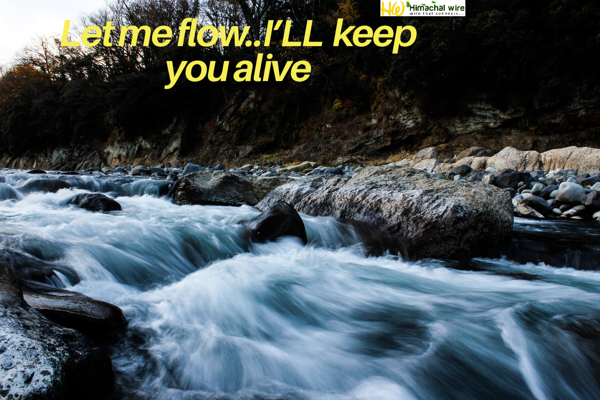The congregation also lent full support to 26 year old Atmabodhanand, an engineering student-turned-seer who has been fasting for more than 100 days at Matri Sadan Ashram in Haridwar for ‘Aviral- Nirmal Ganga’.
“Today is Atmabodhanand’s 105th day of fasting. Before him late GD Agrawal, a former professor at IIT Kanpur who observed fast for 111 days lost his life in AIIMS Rishikesh on Ooctober 11,2018 fighting for the same cause,” said Upmanyu.
The participants pointed out that even as the central government is spending crores of rupees under the ‘Nmamai Gange’ program for cleaning Ganga, the situation of the river has gone from bad to worse in the last four years. They said that this has been underlined in a report of the Central Pollution Control Board (CPCB). Scrapping of all 54 proposed dams on the Ganga and its tributaries,
They demanded that strict action to stop the pollution of Ganga downstream and passing of Ganga Act curtailing illegal sand mining and large scale deforestation in the catchment of the basin.
Abha Bhaiyya of Jagori Grameen said that the Ganga belongs to everyone, not to any one community or state. “The lynching of nature has to be stopped if our coming generations have to survive,” she said.
Sumit Mahar of Himdhara Collective, who had given the call for the programme, added “Its not just Ganga. We are also drawing attention to the pathetic conditions of rivers in Himachal that are the lifelines of the not just this state but other downstream states too. By building hundreds of dams, illegal mining, unbridled pollution we are killing our rivers. This massive destruction can only be checked and stopped if the public and the government come together to take some positive and effective steps “. The activists cite government data claiming that more than 200 dams have either been commissioned, constructed or are under-construction while close to 800 dams and hydro power projects are planned and proposed on different rivers of Himachal Pradesh. These projects have diverted the natural flow of the rivers and streams into tunnels thus drying up the rivers. This impacts not just local communities dependent on water from rivers but also the river and local biodiversity as well as other environmental services.
They pointed that in September 2018 the CPCB in its report had identified seven critically polluted river stretches in the state of Himachal, on Beas, Sirsa, Ashwani, Giri, Pabbar, Markanda and Sukhna rivers. Most of the pollution is because of unchecked and illegal dumping of municipal waste, sewage or industrial effluents.
A 10 point memorandum is being sent to the Chief Minister Jairam Thakur with demands to work towards conserving rivers by making necessary policy changes. The memorandum says,”Smaller streams and tributaries of the major river basins need to be marked for their fragility and sustainability because they support ecological diversity and livelihoods. Thriving fish farms on the river, small home-based eco-tourism initiatives and cultural preservation all become possible in such an environment. These needs to be declared as a “no-go zone” not just for hydro projects but also for large scale sand mining, polluting industries and unplanned construction of both roads and buildings.”
The activists cite government data claiming that more than 200 dams have either been commissioned, constructed or are under-construction while close to 800 dams and hydro power projects are planned and proposed on different rivers of Himachal Pradesh. These projects have diverted the natural flow of the rivers and streams into tunnels thus drying up the rivers. This impacts not just local communities dependent on water from rivers but also the river and local biodiversity as well as other environmental services.
They pointed that in September 2018 the CPCB in its report had identified seven critically polluted river stretches in the state of Himachal, on Beas, Sirsa, Ashwani, Giri, Pabbar, Markanda and Sukhna rivers. Most of the pollution is because of unchecked and illegal dumping of municipal waste, sewage or industrial effluents.
A 10 point memorandum is being sent to the Chief Minister Jairam Thakur with demands to work towards conserving rivers by making necessary policy changes. The memorandum says,”Smaller streams and tributaries of the major river basins need to be marked for their fragility and sustainability because they support ecological diversity and livelihoods. Thriving fish farms on the river, small home-based eco-tourism initiatives and cultural preservation all become possible in such an environment. These needs to be declared as a “no-go zone” not just for hydro projects but also for large scale sand mining, polluting industries and unplanned construction of both roads and buildings.” For protection of the forests, the memorandum has demanded immediate implementation of the Forest Rights Act 2006 so that communities can come forward in conserving their forests by claiming their community rights. Tourism and construction cannot go on unregulated and waste management should be priority of the Municipal bodies. There needs to be a moratorium on large dams till all carrying capacity studies are done, the activists pointed.]]>
For protection of the forests, the memorandum has demanded immediate implementation of the Forest Rights Act 2006 so that communities can come forward in conserving their forests by claiming their community rights. Tourism and construction cannot go on unregulated and waste management should be priority of the Municipal bodies. There needs to be a moratorium on large dams till all carrying capacity studies are done, the activists pointed.]]>



